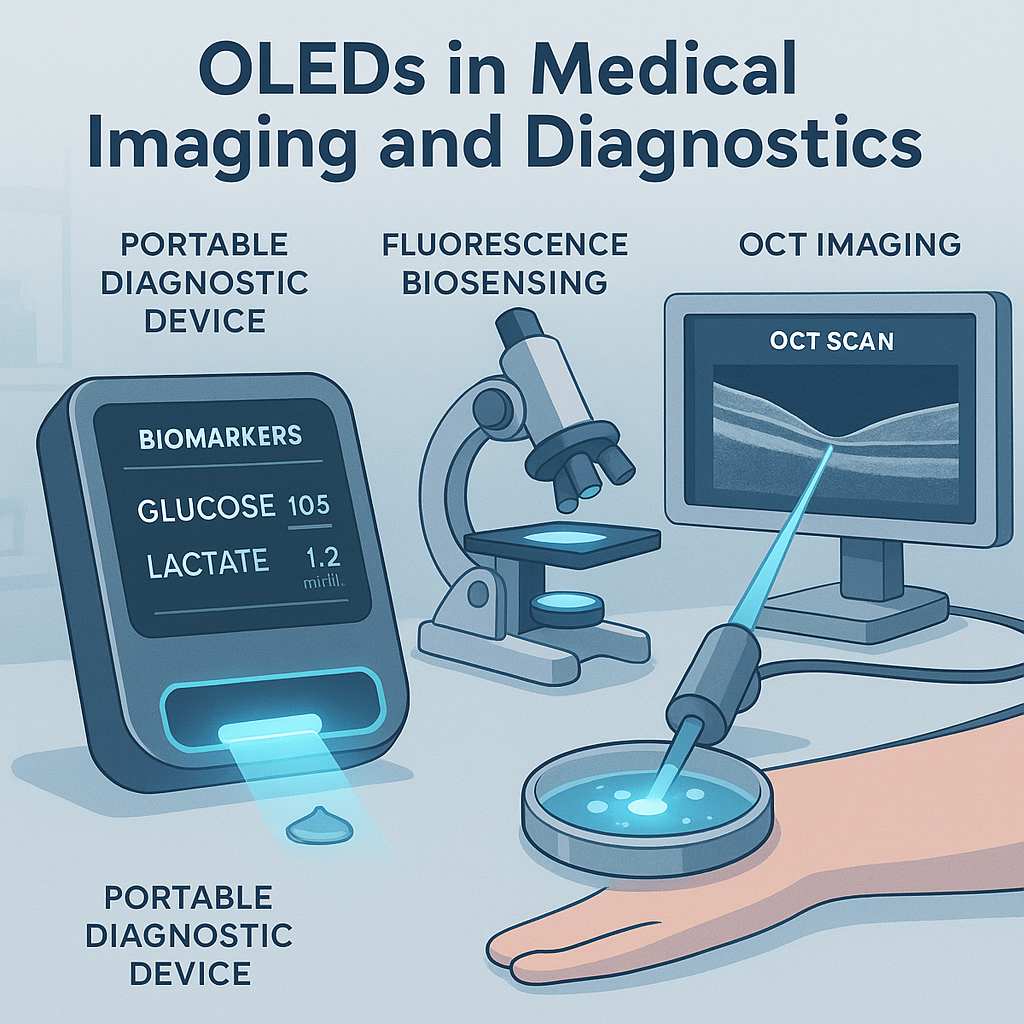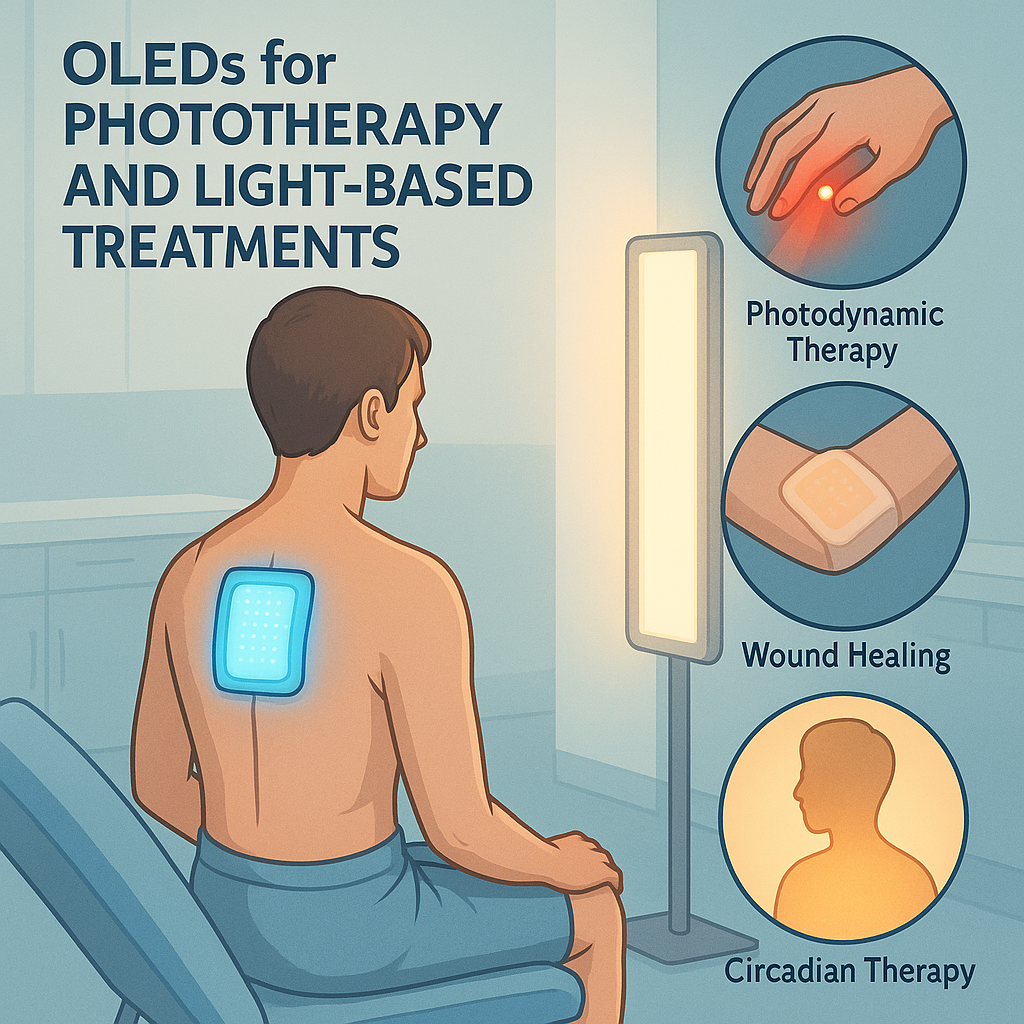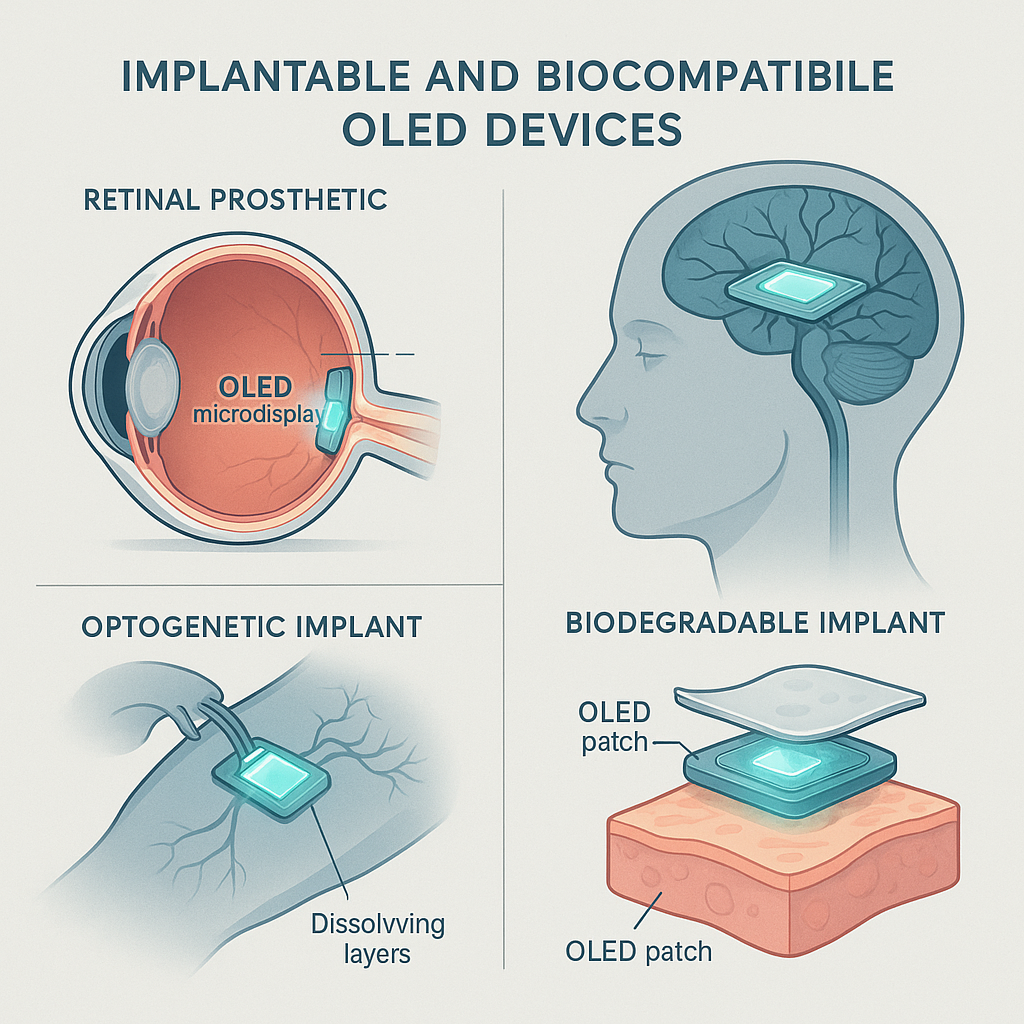Lighting the Future of Medicine: Exploring OLED Applications in Biomedicine
Abstract
Organic Light Emitting Diode (OLED) technology, originally developed for consumer electronics, is now emerging as a transformative tool in biomedicine. This blog explores the diverse biomedical applications of OLEDs, highlighting their advantages such as flexibility, biocompatibility, and efficient light emission. OLEDs are increasingly used in wearable diagnostics, phototherapy, implantable medical devices, and real-time health monitoring systems. Their ability to conform to body surfaces, emit precise wavelengths, and integrate with biosensing platforms makes them ideal for personalized and minimally invasive healthcare solutions. Despite technical challenges like material degradation and long-term stability, ongoing innovations are positioning OLEDs as key components in future medical technologies. This article provides a comprehensive overview of their current uses and future potential in clinical and biomedical settings.
Introduction: OLED Beyond Displays
Organic Light Emitting Diode (OLED) technology has evolved beyond its traditional role in consumer electronics, such as smartphones and televisions, to find transformative applications in biomedicine. OLEDs are unique in their ability to emit light from organic compounds when electrically stimulated. Unlike conventional displays that rely on backlighting, OLEDs are self-emissive, meaning each pixel generates its own light. This characteristic provides the opportunity for much thinner, more flexible, and energy-efficient devices, which is crucial for biomedical applications that demand portability, flexibility, and biocompatibility.
The integration of OLED technology into biomedicine opens up new possibilities for diagnostics, treatment, and real-time health monitoring. One of the primary advantages of OLEDs in this field is their flexibility—a feature that makes them ideal for wearable medical devices, implantable systems, and even flexible displays for real-time health feedback. Additionally, OLEDs are capable of emitting light across various wavelengths, making them highly versatile for applications in imaging, phototherapy, and biosensing.
As OLEDs can be manufactured on ultra-thin and flexible substrates, their integration into wearable devices such as health monitoring patches and biosensors provides significant potential for non-invasive, continuous monitoring of biological parameters. The ability to create ultra-thin OLED displays that conform to the skin or body allows for seamless, comfortable wearability, making OLED a powerful tool in personalized healthcare. Furthermore, the biocompatibility of OLEDs opens doors to using them in implantable systems, such as retinal implants for vision restoration or optogenetics for precise cellular manipulation in brain research.
As this technology continues to develop, OLEDs are poised to revolutionize healthcare, offering a unique blend of functionality, comfort, and innovation.
OLEDs in Medical Imaging and Diagnostics
OLED technology has revolutionized the field of medical imaging and diagnostics, thanks to its unique ability to emit light across a broad range of wavelengths, providing high-resolution, efficient, and compact light sources for various medical applications. One of the most exciting areas where OLEDs are being employed is in biosensors and diagnostic patches. These wearable devices can be embedded with OLEDs to monitor specific biomarkers, such as glucose levels, lactate, or other chemical signals, in real time. OLED-based sensors allow for non-invasive, continuous monitoring, which is essential in managing chronic conditions like diabetes or cardiovascular diseases.

OLEDs also play a crucial role in optical imaging systems used for fluorescence and luminescence detection in diagnostics. In these systems, OLEDs serve as a highly efficient and customizable light source that can be precisely tuned to match the excitation wavelength required for specific biomarkers. This capability enhances the sensitivity and accuracy of diagnostic tests, which can help detect diseases at earlier stages. OLEDs are already being integrated into portable diagnostic devices, enabling healthcare providers to perform on-site tests that would typically require bulky laboratory equipment.
Additionally, OLEDs are utilized in optical coherence tomography (OCT), a non-invasive imaging technique that captures high-resolution images of tissues and organs. OLED-based light sources in OCT systems enable better resolution and contrast, enhancing the detection of diseases like cancer, eye disorders, and cardiovascular conditions. The compact size and energy efficiency of OLEDs make them a promising alternative to traditional light sources, which can be bulky and power-hungry.
With ongoing advancements in OLED technology, their use in medical imaging and diagnostics is expected to expand, offering more accessible, efficient, and patient-friendly tools for early disease detection and ongoing health monitoring.
OLEDs for Phototherapy and Light-Based Treatments
OLED technology is increasingly being explored for therapeutic applications, particularly in the realm of phototherapy—a treatment method that uses specific wavelengths of light to treat medical conditions. Unlike traditional LEDs or lasers, OLEDs offer several distinct advantages: they are thin, flexible, lightweight, and can be fabricated on bendable substrates. This makes them especially suitable for wearable or conformal therapeutic devices that can adapt to the contours of the body.
One of the most promising applications of OLEDs in therapy is Photodynamic Therapy (PDT). In PDT, light activates photosensitizing agents in tissues to produce reactive oxygen species that selectively destroy cancerous or infected cells. OLEDs can be engineered to emit light at the precise wavelength needed to activate specific photosensitizers, offering a targeted, low-power solution for treating superficial cancers, microbial infections, and skin conditions. The flexibility of OLED panels also allows clinicians to design treatment patches that can closely adhere to skin lesions or tumors, improving therapeutic efficacy.

Another emerging application is wound healing. Studies have shown that light in the red and near-infrared spectrum can stimulate tissue regeneration, reduce inflammation, and promote blood flow. OLED-based patches can deliver consistent, low-level light to chronic wounds, ulcers, or surgical sites without causing heat damage, making them ideal for non-invasive and continuous therapy.
Moreover, OLEDs are being investigated for use in circadian rhythm regulation, particularly in treating sleep disorders and seasonal affective disorder (SAD). Their ability to mimic natural light with controlled intensity and spectrum gives them an edge in human-centric therapeutic lighting systems.
As research progresses, OLED-based light therapy devices could become a cornerstone in personalized medicine, offering customizable, safe, and highly efficient treatment options across various medical domains.
Implantable and Biocompatible OLED Devices
A transformative frontier in biomedical engineering is the development of implantable OLED devices, which leverage OLEDs’ compactness, flexibility, and wavelength tunability for use inside the human body. Unlike traditional rigid light sources, OLEDs can be fabricated on biocompatible and even biodegradable substrates, making them promising candidates for temporary or permanent implantation without causing long-term tissue damage or foreign body responses.
One of the most advanced applications in this space is retinal prosthetics, where OLED microdisplays are being explored to restore partial vision in patients with degenerative eye diseases such as retinitis pigmentosa. These devices aim to directly stimulate the retinal neurons with light patterns, effectively bypassing damaged photoreceptor cells. OLEDs are ideal for this purpose due to their ability to emit light with high spatial resolution and low thermal emission, which is critical for delicate neural tissue.

Another frontier is optogenetics, a cutting-edge technique that involves controlling neural activity with light-sensitive proteins. Traditional optogenetic stimulation systems rely on bulky fiber-optic systems, but OLEDs offer a minimally invasive alternative by being thin, flexible, and wirelessly addressable. Implantable OLED arrays can deliver patterned light stimulation to targeted brain regions, enabling new types of research and therapies for neurological disorders.
Biodegradable OLEDs are also under exploration for temporary implants, such as post-surgical therapeutic lights or resorbable diagnostic tools. These devices can perform a medical function and then naturally degrade, eliminating the need for surgical removal. While promising, challenges remain in ensuring long-term stability, minimizing material toxicity, and achieving efficient encapsulation to protect organic layers from body fluids.
Despite these hurdles, the convergence of OLED technology with bioengineering is paving the way for next-generation implantable devices that are safe, effective, and intimately integrated with biological systems.
OLED Wearables and Real-Time Health Monitoring
One of the most promising real-world applications of OLED technology in biomedicine lies in wearable health monitoring systems. These devices capitalize on the ultra-thin, flexible, and lightweight nature of OLEDs to create comfortable, skin-conforming electronics capable of tracking physiological signals in real-time. From smart bandages that detect infection to e-skin patches that monitor heart rate, hydration, or temperature, OLEDs are redefining what wearable medical technology can achieve.
OLED displays are particularly suited for wearable biofeedback systems, where continuous data monitoring is paired with an interactive, low-power display interface. For example, OLEDs integrated into sweat-analyzing patches can display electrolyte levels or dehydration alerts directly on the user’s skin. These displays are not only energy-efficient but can also function under bending and stretching, critical for dynamic environments like sports, rehabilitation, and elderly care.
In combination with photodetectors and organic photodiodes, OLEDs can form reflective pulse oximeters or photoplethysmography (PPG) devices embedded in ultra-flexible wristbands or patches. These measure vital signs such as blood oxygen saturation, heart rate, and respiration patterns without requiring bulky components. Their mechanical flexibility and transparency also make them ideal for multi-modal health platforms, integrating motion tracking, biochemical sensing, and optical imaging in a single unit.
Furthermore, the integration of OLED-based wearables with IoT systems and wireless communication modules enables continuous health tracking and data sharing with clinicians, paving the way for more personalized and preventive medicine models. Patients with chronic diseases such as hypertension, diabetes, or sleep apnea can benefit immensely from unobtrusive, OLED-enabled devices that track their condition around the clock.
As manufacturing costs decline and performance improves, OLEDs are expected to power the next wave of user-friendly, real-time health monitoring technologies that blend seamlessly into daily life.
Conclusion
OLED technology is rapidly expanding its footprint in biomedicine, offering versatile, lightweight, and flexible solutions for diagnostics, therapy, and real-time health monitoring. From powering wearable biosensors and therapeutic light patches to enabling implantable devices for vision restoration and brain stimulation, OLEDs are reshaping how healthcare is delivered. Their unique properties—such as wavelength tunability, biocompatibility, and mechanical flexibility—allow for highly personalized, minimally invasive, and efficient medical applications. While challenges remain in terms of long-term stability and integration, ongoing research continues to push the boundaries of what OLEDs can achieve in clinical and home-care settings. As innovation advances, OLEDs are poised to become central components of the next generation of medical devices, enhancing patient outcomes and enabling smarter, more responsive healthcare systems.
References
Lin YD, Tsai WW, Lu CW. Exploring the Electroluminescent Applications of Imidazole Derivatives. Chemistry. 2023 Apr 21;29(23):e202203040. doi: 10.1002/chem.202203040. Epub 2023 Mar 17. PMID: 36593580.
https://chemistry-europe.onlinelibrary.wiley.com/doi/abs/10.1002/chem.202203040
Swathika M, Natarajan A. Synthesis and photometric properties of efficient white-emitting phosphor of M-AMG transition metal complexes for OLED applications. Luminescence. 2023 Jul;38(7):1230-1243. doi: 10.1002/bio.4365. Epub 2022 Sep 7. PMID: 35986892.
https://analyticalsciencejournals.onlinelibrary.wiley.com/doi/abs/10.1002/bio.4365
Tiwari RK, Mishra R, Sharma SK, Prabhu N, Nagar MR, Grigalevicius S. Advancing Cancer Treatment and Diagnosis: A Review on Photodynamic Therapy Using OLED Technology. Molecules. 2025 Mar 14;30(6):1305. doi: 10.3390/molecules30061305. PMID: 40142080; PMCID: PMC11946556.
https://www.mdpi.com/1420-3049/30/6/1305
Kumar K. Charge transporting and thermally activated delayed fluorescence materials for OLED applications. Phys Chem Chem Phys. 2024 Jan 31;26(5):3711-3754. doi: 10.1039/d3cp03214k. PMID: 38221898.
https://www.mdpi.com/1420-3049/30/6/1305
Sim JH, Kwon J, Chae H, Kim SB, Cho H, Lee W, Kim SH, Byun CW, Hahn S, Park DH, Yoo S. OLED catheters for inner-body phototherapy: A case of type 2 diabetes mellitus improved via duodenal photobiomodulation. Sci Adv. 2023 Sep;9(35):eadh8619. doi: 10.1126/sciadv.adh8619. Epub 2023 Sep 1. PMID: 37656783; PMCID: PMC10854432.




